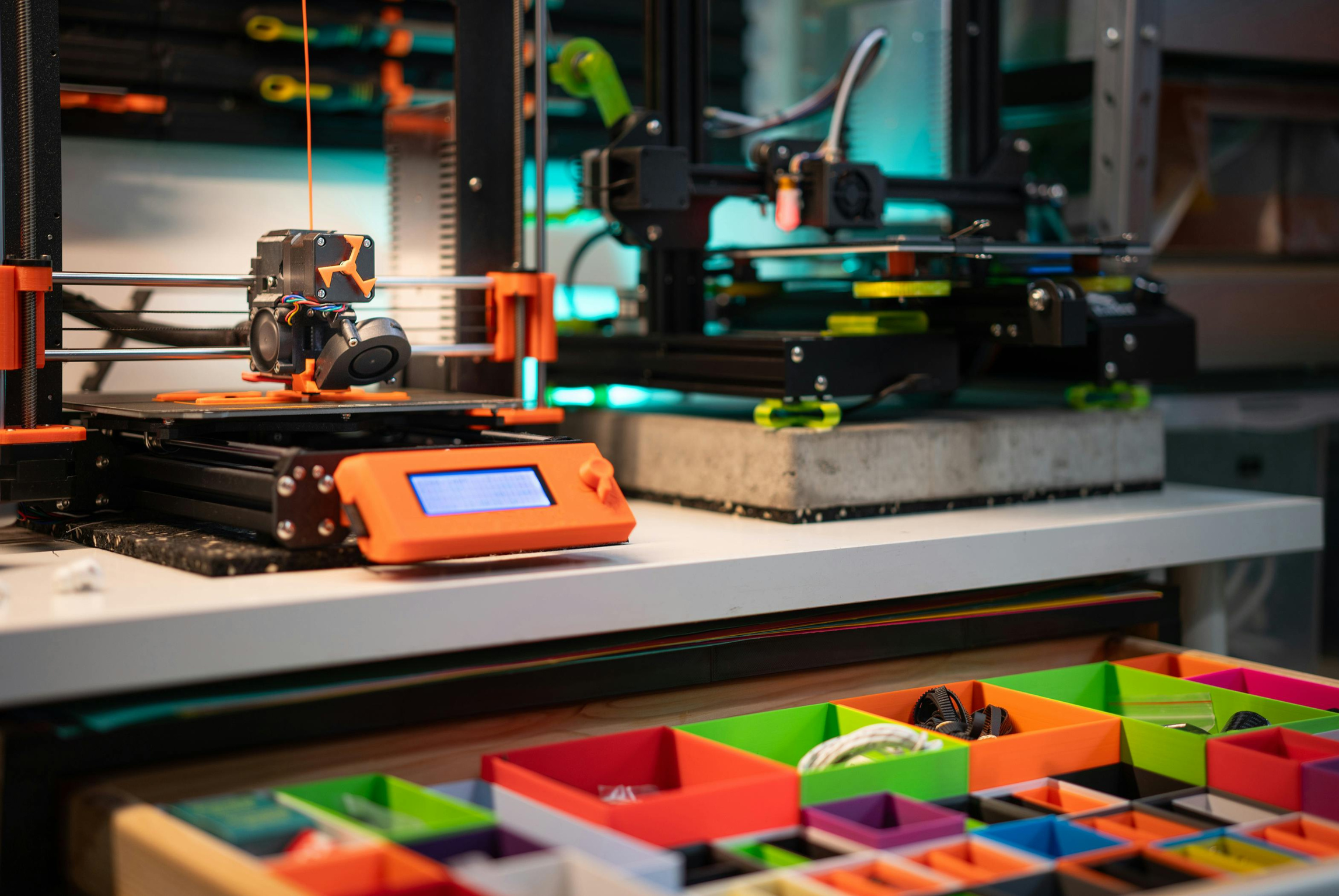
We often hear stories that happen to people working with 3D printing, and it’s not just from beginners. Once they print a complex part like a gear or a movable hinge, everything looks perfect… until they start using it, and it breaks. Perhaps you've encountered this too, or I hope this article will help you avoid such situations. Today, we’re going to talk about nylon filament.
When PLA is too brittle and ABS is too tricky, nylon for 3D printing becomes a real lifesaver. It’s a material that many know about, but not everyone dares to try. But they should. It’s strong, flexible, wear-resistant, and capable of withstanding mechanical stress — precisely what you need when your model has to do more than just "look good" but actually work.
In this article, you'll learn:
- Why and when you should choose nylon
- How to avoid common pitfalls when printing with it
- The temperature settings you should follow
- How to prepare your printer to create strong, reliable, and durable 3D models.
If you're already into 3D printing and looking for a material with real capabilities, you're definitely in the right place.
Why Choose Nylon Filament?
3D printing newcomers are certainly familiar with PLA, and you’ve probably started with it too — it's a good choice because it's easy, affordable, and "forgiving" of mistakes. Maybe you’ve tried ABS with its tricky printing, odors, and the need to heat everything that can be heated. But there comes a time when you want to do more than print pretty models; you want to create functional, reliable items.
If you're making models for construction and need to create a joint, a fastening element, or maybe even a part for repair, regular filaments won't withstand the load. That’s when it’s time to meet nylon filament — the material that people choose when they want their models to work, not just sit on a shelf.
In this section, we’ll explain how nylon for 3D printing differs from other filaments, what benefits it offers, and when it's exactly what you need. If you feel it's time to take your 3D printing to the "next level," keep reading.
Exceptional Strength and Durability
Nylon is known for its high tensile strength and impact resistance, making it ideal for functional parts that are exposed to mechanical stress. Whether you're printing gears, brackets, or tool handles, nylon will ensure the longevity of your creations.
For example, if you're designing a special gear for an old bicycle or a clamp that needs to withstand tension, nylon doesn't just survive, it thrives under pressure. You won’t have to worry about the material cracking or breaking as PLA might after a few uses in such applications.
Flexibility Without Compromise
Unlike rigid materials like PLA or ABS, nylon offers a balance between flexibility and stiffness. This means it can bend under load without breaking, which is particularly important for parts like hinges, clamps, or wearable items that require some flexibility.
Consider a belt clip or a fastener. You want it to bend enough to attach, but not so much that it loses its shape. Nylon gives you that perfect balance where form and function come together without compromise.
Low Friction and Abrasive Wear Resistance
Nylon has a low coefficient of friction and excellent wear resistance, making it ideal for moving parts. Components like bushings or rails benefit from these properties, ensuring smooth operation over time.
If you’ve ever tried to print a drawer rail or a mechanical connection, you know that some materials wear out quickly or start squeaking. Nylon handles these situations easily. It ensures smooth operation even with frequent movement or prolonged use.
Resistance to Chemicals and High Temperatures
Nylon is resistant to many chemicals, including oils and fats, making it suitable for industrial applications. Its high deformation temperature also allows it to perform in environments where other plastics may deform.
Nylon is the perfect choice for parts that need to work inside a motor housing or near an engine, where temperatures rise, oil splashes, and vibrations continue. Unlike other materials that may soften, deform, or even fail, it maintains its strength.
Affordable Eco-Friendly Options
Innovations in recycling have led to the emergence of eco-friendly nylon filaments. For example, companies like Fishy Filaments turn used fishing nets into high-quality nylon suitable for 3D printing, offering a sustainable choice without sacrificing performance.
This way, you can create durable and functional components while positively impacting the environment. By choosing recycled nylon, you contribute to a circular economy without compromising print quality.
In summary, if your 3D printing projects require parts that need to be strong, flexible, and durable, nylon filament is an excellent choice. Its unique properties open up possibilities for functional prototypes and final components, especially when you’re ready to move beyond decorative printing and start making things that actually work. Now, let’s see where else nylon can play a key role.
Top Use Cases: When Nylon is the Best Choice
For 3D printing enthusiasts looking to move from decorative models to functional, durable components, nylon filament offers a compelling solution. Its unique combination of strength, flexibility, and chemical resistance makes it perfect for various applications:
Mechanical Components
Nylon’s high tensile strength and impact resistance make it a great choice for manufacturing gears, hinges, and brackets that need to withstand mechanical stress. For instance, a special nylon-printed gear can handle torque and wear with daily use, outlasting more fragile materials like PLA. This durability is essential for parts that require both strength and longevity.
Wear-Resistant Parts
With its low friction coefficient and excellent resistance to abrasive wear, nylon is perfect for parts that undergo constant movement or friction, such as bushings or conveyor belt components. These properties ensure the integrity of parts over time, reducing the need for frequent replacements.
Functional Prototypes
When developing prototypes that need to withstand real-world conditions, nylon’s durability is invaluable. Its ability to absorb impacts and resist chemicals allows for thorough testing and iterations, ensuring the final product meets all performance standards.
Custom Tools
Nylon’s strength and flexibility make it ideal for creating jigs, fixtures, and other custom tools designed for specific tasks. Whether a specialized clamp or a unique assembly aid, nylon ensures these tools perform under expected loads without breaking.
How to Print with Nylon – Without the Pain
So, you've probably already formed an opinion about nylon filament as an ideal material for durable, flexible, and impact-resistant 3D prints. But you may have also heard the talks: "Nylon is difficult to print." Stringing, warping, mysterious clicking sounds when moisture is involved...
We understand that printing with nylon has earned a reputation. But here’s the good news: with the right preparation and settings, you can unlock the full potential of nylon without the headaches. Whether printing high-stress gears, strong clips, or your first functional prototype, this guide will walk you through everything from temperature settings to choosing the right print bed surface and keeping your filament dry. Let’s make your nylon 3D prints professional👇
Temperature Settings
Nylon is not your typical beginner filament – it likes the heat. For smooth extrusion and strong layer bonding, the extruder temperature should be between 240°C and 260°C. If your printer can’t support this range, you may face issues like under-extrusion or weak part strength.
The bed temperature is also crucial. A garolite bed (G10/FR4) works best at 55°C to 65°C, providing solid adhesion without warping. If you’re using a glass bed, raise the temperature to 70°C-80°C and apply a layer of PVA glue to create a sticky surface that nylon loves.
What’s often overlooked? Consistency. Nylon’s performance drops significantly if the temperature fluctuates, so a stable thermal profile is key to successful printing.
Drying the Filament
Here’s the reality: nylon is a magnet for moisture. Even just a few hours in a high-humidity room can lead to bubbling and clicking sounds during printing, making the parts weak and porous. That’s why proper drying is not an option, and it’s a necessity.
Set a filament dryer or convection oven to 80°C-100°C and leave it for 8-12 hours, depending on the humidity in your area. Some makers even store their spools in vacuum-sealed boxes between prints. The difference in print quality – clearer layers, smoother surfaces, and stronger parts – becomes evident once the moisture is gone.
Bed Surface and Adhesion
Adhesion is the battle we all face when printing with nylon. It’s prone to warping and lifting if the first layer isn’t securely attached.
The gold standard is garolite – it grabs nylon well without the need for sprays or glues. But if you have a glass bed, a generous layer of PVA glue will suffice. You can also try Magigoo PA or other specialized adhesives.
Pro tip: Don’t use a cooling fan – nylon loves heat, and strong airflows can cause corners to lift. Keep the environment warm and stable.
Printer Requirements
Before starting the print, check your equipment – not all printers are suited for nylon. Start with a fully metal extruder; PTFE-coated extruders can degrade at nylon’s high temperatures and release toxic fumes. The extruder should consistently maintain temperatures from 240°C to 260°C.
You'll also need a heated bed that can reach at least 70°C and a fully or partially enclosed print chamber to maintain a stable temperature. Nylon can’t handle drafts or sharp cooling.
Some enthusiasts even build their own enclosed setups using IKEA Lack tables or printed tents. If you’re serious about printing with nylon, consider machines like the Prusa MK4, Bambu Lab X1 Carbon, or Pulse XE, which are designed to work with advanced filaments.
Recommended 3D Printers for Nylon
When it comes to 3D printing with nylon, choosing the right printer is crucial. Nylon requires:
-
High extrusion temperatures
-
Stable bed temperatures
-
A protected environment from external factors (like temperature fluctuations and drafts)
That’s why it’s important to choose printers specifically designed for high-temperature and tricky materials.
Printers with all-metal hotends are a must because they can withstand higher extrusion temperatures, which are necessary for stable nylon prints. Examples include the Prusa MK4, Bambu Lab X1 Carbon, and Ultimaker S3/S5, which are equipped with high-quality hotends and can support temperatures up to 300°C, perfect for nylon.
Additionally, a heated bed is essential. For nylon, it’s recommended that the bed temperature reaches 70–80°C for optimal adhesion and to prevent warping. Enclosures are also critically important: they help maintain a stable temperature throughout the print, minimizing the risk of thermal shifting and part warping. Models like the Pulse XE and Raise3D Pro2 offer full or partial enclosures, making them ideal for nylon and other high-temperature materials.
For experienced users planning to print with composite filaments based on nylon, printers like the Markforged Onyx One or 3D Systems ProX 800 can deliver excellent results thanks to their capabilities for printing with carbon fiber-reinforced and other enhanced materials.
Also, pay attention to compatibility with specialized nylon tools, such as heated beds and temperature-controlled systems, which help achieve higher print precision and part durability.
So when choosing a printer for nylon, always check the technical specifications to ensure it can handle high temperatures and maintain a stable printing environment. And again, we’re not stopping at the opinion that if you want to do it well, use only nylon. Let’s break down when NOT to use it.
When Not to Use Nylon
Despite its many advantages, nylon isn’t always the best choice for every type of project. It’s important to know when to use it and when another material would be a better option.
1. Aesthetic Models
If your goal is to create aesthetically appealing models with high-quality finishes, nylon may not be the best choice. Nylon tends to have surface defects and can be tricky to achieve a smooth finish, especially if you’re not using the right print settings and post-processing techniques.
For models where appearance and surface smoothness are important, materials like PLA or ABS will be more convenient, as they provide a cleaner, smoother surface with less effort.
2. High-Humidity Environments
Nylon is a hygroscopic material, meaning it actively absorbs moisture from the air. This can lead to printing defects, such as bubbles, unevenness, or even extruder damage. In high-humidity environments, if you don’t ensure proper drying and storage of nylon, printing may be disrupted.
For those living in areas with high humidity, it’s critical to use humidity filters or filament dryers (e.g., set to 80–100°C) to avoid problems. In these cases, alternatives like PETG or TPU, which are less sensitive to humidity, may be more suitable.
3. Printers Without Heated Beds or All-Metal Hotends
As mentioned, nylon requires high extrusion temperatures (240–260°C) and a stable heated bed temperature (70–80°C for optimal adhesion).
If your printer doesn’t have an all-metal hotend or a heated bed, printing with nylon can result in warping, poor adhesion, and unstable prints. In these cases, it’s wise to opt for more suitable materials, such as PLA or PETG, which require lower temperatures and can work with less advanced equipment.
4. When to Opt for Alternatives
If your tasks involve printing aesthetic models with smooth surfaces or working in high-humidity environments, materials like PLA, PETG, or TPU can offer you more convenient and stable results. These materials are easier to use, less sensitive to external conditions, and suitable for various 3D printers, even those that don’t have specialized equipment for nylon.










